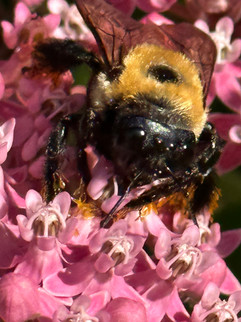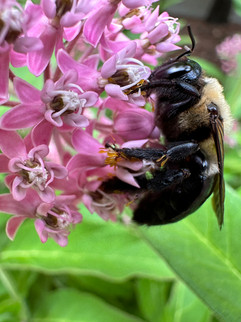This non-native honey bee has found out the hard way what happens when it gets its claw stuck in a milkweed flower's astigmatic chamber. If it can free itself, the pollinia will be stuck to its claw or leg.
Pollinia (plural) are waxy masses of pollen located in the stigmatic chamber of milkweeds and orchids. A bee can unload these pollen sacs. To achieve cross-pollination, the pollinium (singular) has to slip into a stigmatic slit of a different flower of the same species (milkweed) and the stigmatic chamber must be empty. Sometimes a claw or part of the leg may be left behind while trying to free itself. That's a tough price to pay for the nectar that lures it in.

Floral structure of Asclepias flowers, showing stigmatic chambers between five saccate hoods, and pollinaria of each species, including a black, grooved corpusculum attached to two saccate pollinia. Drawings by Butch Colyear.
If the bee cannot free itself, it will die there. I have had my share of freeing European honey bees from many milkweeds as I find it a cruel way to die after being rewarded with such sweet nectar. What about the butterflies that visit milkweed? No need to worry as their slender legs do not usually get stuck in the stigmatic slit.
Eastern Carpenter bees (Xylocopa virginica), my favorite, are the most important pollinators of milkweed. Their legs are also thick and hairy allowing them to step right into the flower and come out covered in pollinia. They are strong fliers and can carry extra weight. They can also pollinate in the rain! Our large native digger wasps do not get stuck either for the same reasons.
The next time you see a milkweed seed pod, think about all the work that went into producing it.
Photos by KMS Native Plants: Carpenter bees with pollinia on their legs and claws. The one sitting on my finger is a male. The white patch on its face is how you sex male carpenter bees. The last one is the great black digger wasp (Sphex pensylvanica). Look closely and you will see the pollinia.
References:
1. Kephart, S., & Theiss, K. (2004). Pollinator-mediated isolation in sympatric milkweed (Asclepias): Do floral morphology and insect behavior influence species boundaries? New Phytologist, 161(1), 265-277. https://doi.org/10.1046/j.1469-8137.2003.00956.x











Thanks for that. Pretty amazing.